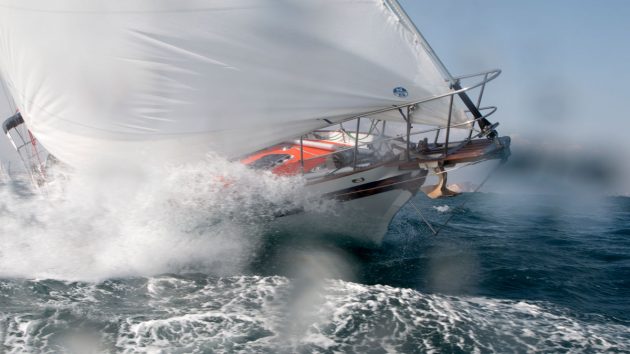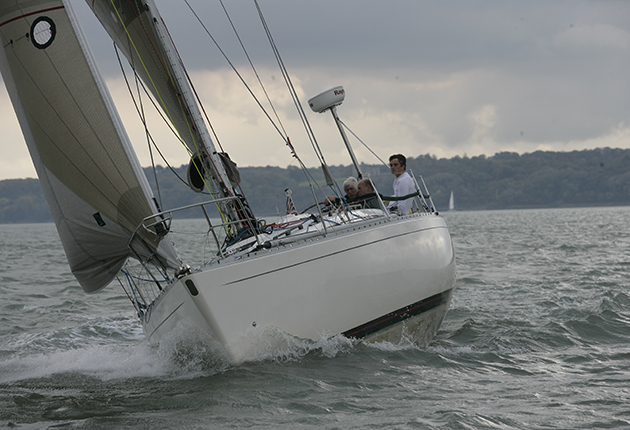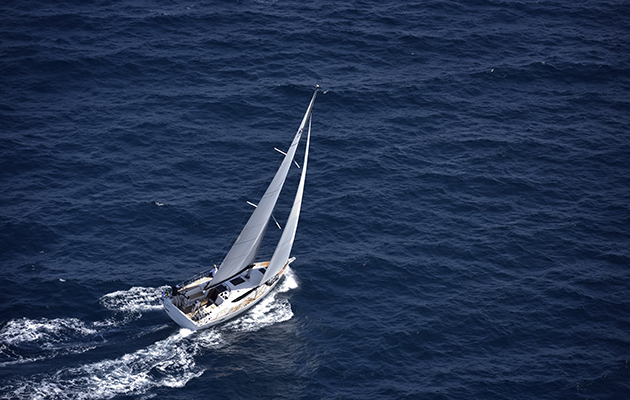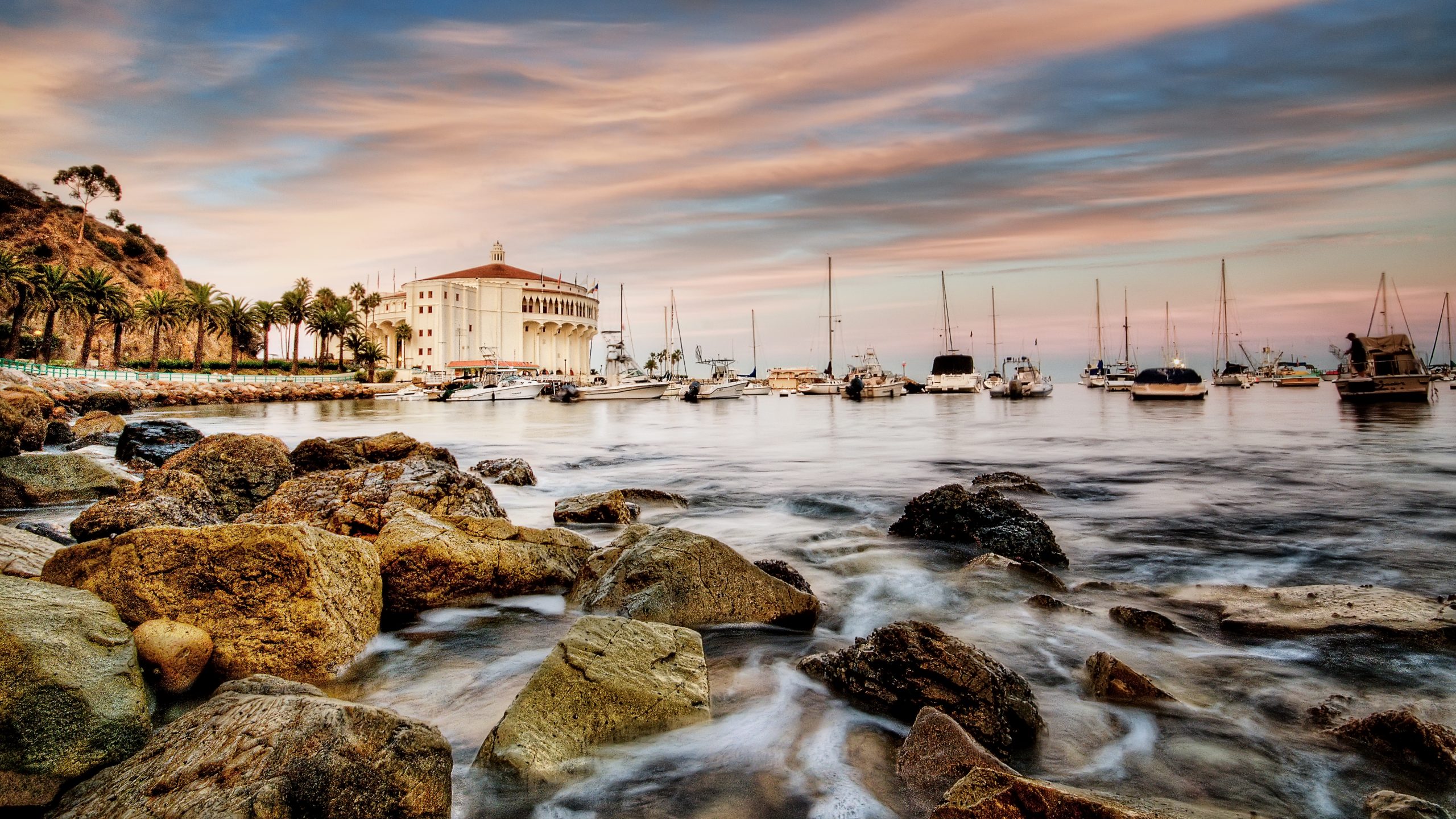With the pressure of winter storms on the horizon, Pete Nielsen is struggling to make meaningful progress south to Florida, and then the boat steering fails
Boat steering failure on a lee shore: one sailor shares his experience
Towards the end of autumn 2018, I was trying to move Minx, my Pearson 39-2, south from Salem, Massachusetts to Jacksonville, Florida, writes Peter Neilsen.
Things had not gone well. Two weeks after leaving, I had only covered 130 of the nearly 1,000-mile passage, getting as far as New London, Connecticut.
A never-ending series of nasty fronts had made it impractical to do more than port-hop, and during the few good weather windows I’d had work commitments that required internet and a non-pitching desk.
Winter on America’s East Coast is not to be trifled with –there’s a good reason insurance companies want boats out of the water by the end of October – and it was getting colder by the day.
So, by the time my friend Pat joined me for the remainder of the passage, I was feeling the pressure to get to Norfolk, Virginia, where we could enter the Intracoastal Waterway and avoid the offshore gales.

Sailing down the coast of Long Island. In hindsight, Peter should have sailed closer to land. Credit: Peter Nielsen
We left New London at the beginning of November, planning to sail outside Long Island for a 209-mile overnighter to Cape May.
The forecast predicted a northwesterly wind going south-east at 15-20 knots, which would give us a fast reach down the Long Island coast and past the shipping lanes leading out of New York.
We slipped the lines and enjoyed a few hours of fast reaching down the south of Long Island.
At 0200, the breeze was up to 18-20 knots and we put in the second reef. By 0400 it was blowing low 20s and the sea state was getting interesting.
We were bucketing along at 7-9 knots in the pitch-black and every so often a big growler would rear out of the murk and lay the old girl on her beam ends.

Peter Nielsen’s route. Credit: Maxine Heath
Soon we were getting gusts in the high 20s. Since we were going fast in the desired direction I wasn’t overly concerned.
At the 0400 watch change I found Pat looking extremely green and clutching a sick-bag; it was clear I was now solo and a change in plans was called for.
I decided to wait until daybreak to make the decision when we would be between Atlantic City and Cape May, some 35 miles further on.
By now the wind had backed to the east and kicked up a competing wave train. Short square-topped waves attacked from astern and from the beam; no more than 6-8 feet, not dangerous but completely unpredictable.
One would pass under us from our beam, lifting us and laying us over. The next would crash against the stern, skewing us to windward so the following wave would break near the bow and send a few buckets of warm spray back to the cockpit.

Peter Nielsen is a former assistant editor of Yachting Monthly and has sailed in Europe, the Mediterranean, the Caribbean, and along the East Coast of the USA. After retiring as editor of SAIL magazine in 2020, he refitted his 1987 Pearson 39-2, Minx, for long-term cruising and is currently sailing the Eastern and Western Caribbean.
Each time the stalwart autopilot brought us back on course.
With the genoa reefed halfway and two tucks in the main, I tried hard to think of a better sail combination, but since the boat and autopilot seemed to be happier than I was, I left things as they were and braced myself in the cockpit.
Long story short: it was probably the most unpleasant night at sea I have ever experienced. By the time the sun was rising I was fed up and had decided to run into Absecon Inlet, which leads to Atlantic City.
As the casinos of North America’s gambling capital gradually appeared out of the grey mist it became obvious that the shoaling waters were teasing the steep seas into washing machine mode.
I started the engine, rolled away the rest of the jib, and chicken-gybed – tacked instead of putting the stern through the wind – to put the breeze on our starboard quarter as we made the run in.

Minx refuelled for her next leg towards Florida. Credit: Peter Nielsen
I briefly contemplated dropping the mainsail, but it would have been too dangerous in that sea state, and I would need it if the engine failed.
By now it was a solid 25 knots true, and we were occasionally surfing down waves that hit maybe 10 feet.
The first channel markers appeared right on cue, then the second. And right as we passed between them, I felt the stern lift to the biggest sea yet and caught a glimpse of the speed log reading 14 knots as we slewed to starboard and hurtled towards the red can.
I put the wheel down hard, felt the rudder bite, and then there was a bang below my feet and the wheel spun freely in my hands.
Continues below…
Things to practise in harbour – fitting the emergency tiller
James Stevens explains which skills are best to perfect while you have plenty of time to do so. This week,…
Rudder failure on a lee shore. What do I do?
Would you know what to do if the rudder failed as you approached a lee shore? James Stevens answers your…
Offshore sailing skills: All you need to know
Will Bruton finds out what coastal cruisers should consider before taking their small yacht on an offshore adventure
Sailing America: 10 of the best spots to cruise in the US
Sailing America opens up wide and varied cruising grounds, taking in the Pacific and Atlantic oceans, as well as temperate…
Steering failure – a sailor’s nightmare, and happening above a lee shore. My mind went blank for a moment.
‘This is going to end really badly,’ was my first thought. We were going to end up on the Riprap, the line of rocks along the shoreline where the waves were breaking half a mile to leeward.
Minx slowly turned broadside to the seas, wallowing in the troughs as she drifted to leeward, virtually hove-to under reefed main only.
I sheeted in to try to get some drive away from the shore.

A nasty case of crevice corrosion caused the steering chain to snap. Credit: Peter Neilsen
We were in 15ft of water, and I did not know how long it would take before we washed up on the ragged shoreline that foamed white to leeward.
I did not think it would be long. I knew where the emergency tiller was, buried at the bottom of the cockpit locker.
I would have to remove the wheel to use it, and with the rudder slamming back and forth as the boat rolled, fitting it would not be easy.
We could anchor, but with the boat pitching so much in the steep seas and snatching violently at the chain this would present problems of its own.
Pat, alerted by the sudden change in movement, appeared in the companionway, still groggy. I did what I thought I would never have to do.

A new steering cable and chain arrived in two days. Credit: Peter Neilsen
I asked him to call a Mayday. I knew there was a U.S. Coast Guard station close by, and that they would respond immediately.
I much preferred the thought of being taken under tow to the alternatives I had considered.
But then, as Pat was describing our predicament to the Coast Guard, my eyes lit on the autopilot control on the binnacle and almost of its own volition my left forefinger moved forward and pressed the ‘auto’ button.
The engine had been idling quietly throughout the drama and now I engaged forward gear and stabbed the 10° button three times to bring the bow round to starboard just as the Coast Guard RIB raced into sight.

Replacing the boat steering cables was not easy. Peter had to cut a bigger hole for access, cutting his hand on sharp edges. Credit: Peter Neilsen
How to describe this epiphany?
My previous boat had a wheel pilot, and I had completely blanked on the fact that the Minx was blessed with a below decks drive connected to a tiller arm.
This of course meant that she could be steered independently of the wheel.
There was probably less than 10 minutes between the steering failure and this realisation. The rest of the story is anticlimactic.
We motored into the broader channel, then used the autopilot to turn into the wind to drop the mainsail.

Too little too late? Trying the emergency tiller for size. Credit: Peter Neilsen
The Coast Guard insisted on hip-towing us into the Farley State Marina, where they left us at a desolate dock pondering the fickleness of fate.
Next morning we moved the boat around the corner to a spot just in front of the Golden Nugget Casino.
And the steering? One of the cable-to-chain links had rusted through. It snapped at the most inopportune moment, not that there’s an opportune moment for anything like that.
I’d greased the chain earlier that year and had not noticed the corrosion.
Edson shipped me a new chain and cable kit, and we were soon back in business.
Meanwhile, a cheerful Coast Guard officer turned up the following day and went through the boat in the most thorough safety check I’ve experienced.
Boat steering failure on a lee shore: lessons learned
- Call a Mayday: It was a tough decision but the right one to call a Mayday. Anchoring would have been dangerous for the person on the foredeck, and there was no guarantee the cleats or chain would have held in those steep seas. The time taken to remove the steering wheel and retrieve and fit the emergency tiller may have seen us in the shoals.
- Head to refuge: Going into Atlantic City rather than sailing another four or five hours to Cape May was the right decision. I was already fatigued after being awake for most of the preceding 24 hours, and Pat, in his own words, was ‘more seasick than I’ve ever been.’
- Own a solid autopilot: I now consider a solid below decks autopilot an essential safety measure and will never again own a boat with
a wheelpilot. - Headsail stowage: I made sure I had stowed the headsail before entering the channel. Trying to roll up a flogging jib in the middle of everything else would have further complicated matters.
- Regular checks: My checks of the steering gear had not been sufficiently rigorous.
- Accept schedule changes: I pushed too hard to get south. I knew the perils of trying to sail to a schedule and ignored them.
- Be ready for anything: We did not have the emergency tiller ready to go at a moment’s notice. Then again, nor has anyone else I’ve ever sailed with.
- Head inland: Had we gone down Long Island Sound, we would have been out of the seas with more options to stop if the weather turned sour.
Enjoyed reading this article?
A subscription to Yachting Monthly magazine costs around 40% less than the cover price.
Print and digital editions are available through Magazines Direct – where you can also find the latest deals.
YM is packed with information to help you get the most from your time on the water.
-
-
-
- Take your seamanship to the next level with tips, advice and skills from our experts
- Impartial in-depth reviews of the latest yachts and equipment
- Cruising guides to help you reach those dream destinations
-
-
Follow us on Facebook, Twitter and Instagram.








